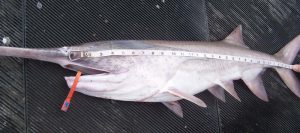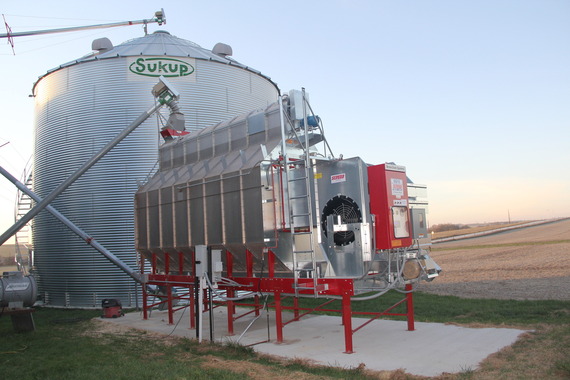CLICK HERE for the latest market quotes from the Iowa Agribusiness Network!
CLICK HERE for the latest market quotes from the Brownfield Ag News Network!
CLICK HERE for the latest market quotes from the Iowa Agribusiness Network!
CLICK HERE for the latest market quotes from the Brownfield Ag News Network!
(Iowa DNR News) – The paddlefish snagging season on the Missouri and Big Sioux rivers opens Feb. 1 and goes through April 30 (sunrise to sunset). The Iowa Department of Natural Resources says anglers fishing for paddlefish must have a valid Iowa fishing license, along with a special paddlefish license and unused transportation tag(s).
Please keep track of your catch and effort and complete the electronic survey after the paddlefish season whether you harvested a fish or not. The information collected will help the Iowa Department of Natural Resources (DNR) evaluate the success of the season and determine what potential changes/modifications may be needed.

Paddlefish-DNR photo
If you catch a jaw-tagged fish (numbered band in the lower jaw), call the phone number on the tag and report the tag number, date of capture, capture location and eye-to-fork length. The Iowa DNR and other state fisheries agencies tag paddlefish to better understand and manage populations. Tagging provides valuable information to estimate population size, fish movement and growth.
Ongoing drought conditions and low river levels might affect Missouri River boat ramp access. For more information about Iowa’s special paddlefish season regulations, visit the DNR website at www.iowadnr.gov/paddlefish.
(Radio Iowa) – A state expert says the snow this month is going to be a help after months of drought. Iowa D-N-R hydrologist, Tim Hall, says there are some indications melting snow will provide some help for depleted soil moisture. “The numbers I’ve seen suggest that the ground frost is not particularly deep in the state because the really cold weather we just came through happened after we had a pretty decent snow cover on the ground, which tends to insulate the soil a little bit,” he says. Hall the ground is often frozen in January and there isn’t any seeping into the subsoil “So if we were to have a rapid melt off, most of the snow would end up in runoff off the top of the ground. So that’s not the best for soil moisture replenishment,” he says.
Hall says the snow melt will be beneficial one way or another. “That moisture is going to go somewhere, and right now whether it goes into the soil or goes into the streams, either one is a good thing for the state of Iowa,” Hall says. Snow runoff will help bring the water levels back up in rivers, streams and lakes. “Those communities that are working hard to keep up with their water demand, this will be helpful,” he says. “Now it still is the time of the year when there isn’t a lot of water demand, so we’ll just keep sticking water into the system and hopefully we can save it up to the growing season next year.” Hall says there could be some flooding if the snow melts rapidly, but he says the drought has created a lot of capacity in lakes and rivers.
“If you recall about a year ago, we were sitting on record snowpack in Minnesota in Wisconsin. And that snow melted off and we had flooding on the Mississippi River in late spring of last year. But because the overall Midwest has been so dry, that flooding came and went and the Mississippi River was back in low flow conditions by summer,” he says. Hall says that something could happen this year in Iowa if the runoff happens quickly.
DES MOINES, Iowa, Jan. 22, 2024 – U.S. Department of Agriculture (USDA) Rural Development State Director in Iowa Theresa Greenfield today (Monday) announced that USDA is investing $18,211,903 in 183 projects across the state to lower energy bills, generate new income, create jobs, and strengthen competition for Iowa agricultural producers and rural small business owners with funding through the Rural Energy for America Program (REAP).
“Producers and small businesses across the state are saving money, growing their businesses, and addressing climate change by investing in solar projects and making energy efficiency improvements through the USDA Rural Energy for America Program,” said Director Greenfield. “The Biden-Harris Administration is hard at work making sure as many Iowans as possible can access the historic Inflation Reduction Act funding to make clean energy improvements at their farms and businesses.”
Today’s projects are part of a larger nation-wide announcement for the REAP program. A list of the nationwide investments may be found online here.

On Nov. 9, 2021, Xochitl Torres Small, USDA Rural Development Under Secretary, visited a farm in Audubon County, Iowa. She met a farmer who received a USDA Rural Energy for America (REAP) program grant and looked at the grain drying system the grant helped provide for the farm business there. USDA photo by Cecilia Lynch
Latest REAP grants in Iowa
A full list of today’s awards in Iowa is available online here and includes these five examples:
-CS Solar LLC received a $206,792 grant to help install a 29 kilowatt rooftop solar system and a 164 kW ground solar system on city property in Decorah. This project in Winneshiek County is expected to generate $40,987 per year in energy sales, which is enough electricity to power 23 homes.
–Red Lion Creston Schools Solar LLC, an electric generation company, received a $1,000,000 grant to help install solar arrays totaling 1,771 kilowatts in Creston. This project in Union County will generate 2,346,020 kilowatt hours per year, amounting to $151,822 per year. This is enough electricity to power 216 homes.
–Southwest Iowa Renewable Energy LLC received a $1,000,000 grant to install a slurry heating and reduced backset system at its dry-mill ethanol production facility in rural Pottawattamie County. This project is expected to realize $3,181,600 per year in savings and to replace 36,688,453 kilowatt hours per year, which is enough electricity to power 3,385 homes.
-Red Lion Knoxville Waterworks Solar LLC, an electric generation company, received a $800,000 grant to help install solar arrays totaling 1,056 kilowatts at six locations in Knoxville, in Marion County. This project is expected to generate 1,340,560 kilowatt hours per year, amounting to $81,499 per year. This is enough electricity to power 123 homes.
-Mara Transport Inc., a family-owned and operated over-the-road trucking business located in Marshall County, received a $21,949 grant to help install a 34.6 kilowatt solar array for business needs. This project is expected to save $5,584.67 per year and to replace 33,968 kilowatt hours—100 percent of the business energy usage—per year, which is enough energy to power three homes.
(Massena, Iowa) – The Cass County Conservation Board is holding Cabin Fever Escape program. The program/open house will be held at the Outdoor Educational Classroom outside Massena, IA on January 27th, from 1-until 4-p.m. There is no charge, and all ages are welcome to attend. Cure your cabin fever and have some family fun!
Bring your mugs, sleds, and dress for the weather. Snowshoes, and cross country skis will be available to use. If you get cold, warm and tasty drinks and a movie will be playing inside the Outdoor Classroom lodge. There will be no snow activities planned as well.
 To reach the Outdoor Classroom, take Highway 148 south of Massena, turn left on Tucson Road and follow it east for about two miles, then make a right-hand turn into the parking lot. The Cass County Conservation Board hopes you will take the time to join them for the free, family event on January 27th.
To reach the Outdoor Classroom, take Highway 148 south of Massena, turn left on Tucson Road and follow it east for about two miles, then make a right-hand turn into the parking lot. The Cass County Conservation Board hopes you will take the time to join them for the free, family event on January 27th.
DES MOINES – The Iowa Department of Natural Resources (DNR) is offering a six-month workshop to teach skills needed to hunt, field dress and cook white-tailed deer to individuals who have little to no archery hunting experience.
Experienced instructors will lead the workshop which includes hunting opportunities throughout Iowa’s archery season. The course, designed for participants 21 and older, will be hosted in Adel, Ames, Council Bluffs, Davenport and Iowa City.
Participants will spend the summer months becoming proficient archers with compound bows provided by Iowa DNR. As summer progresses, they’ll learn basic strategies for hunting deer such as proper equipment, where to hunt, safe shooting practices, and tree stand placement. During the fall, participants will learn how to field dress, clean and cook deer from professional butchers and local chefs.
“For those interested in the challenge of bow hunting as a means of sourcing their own meat, this program provides the opportunity to learn the skills and knowledge it takes to do it all yourself,” said Jamie Cook, Hunter Education coordinator with the Iowa DNR.
Applications will be accepted beginning Jan. 16 for all locations. Once accepted, participants will be invited to register for the course. The course cost is $200 which includes course supplies and archery loaner equipment. Applications will be accepted through May 15 or until registration is filled. Space is limited so early registration is encouraged.
For more information and to begin the 2024 Field to Fork application process, go to https://forms.gle/VTGjbq3vBEkieFZr7
The program is provided through a partnership with Raised at Full Draw, The Iowa Bowhunters Association, Johnson, Linn and Story County Conservation, and other various local partners and archery retailers. It is part of a national effort to recruit, retain and reactivate hunters due to the overall decline in hunting and outdoor recreation.
(Iowa DNR News) – Snowmobilers across Iowa are welcoming the return of winter, eager to get out and enjoy the fresh snow. Snowmobiling is a great way to enjoy the outdoors during the winter months, but there’s one hard truth: drinking alcohol and/or consuming drugs and riding just don’t mix.
“It’s important to remember that operating any type of motor vehicle, including snowmobiles, while under the influence of alcohol or drugs can cause traumatic injuries, tragic loss of life, and is flat-out against the law,” said Captain Matt Bruner with the Iowa DNR’s Law Enforcement Bureau. “We recommend snowmobile riders of all ages take a snowmobile safety course, don’t outride your abilities or trail conditions, and perhaps most importantly, don’t drink and ride.”
The following safety tips will make snowmobiling a great experience with all recreation explorers:
The Iowa Department of Natural Resources and Mothers Against Drunk Driving (MADD) are teaming up to promote a safe and sober snowmobile season by hosting a booth at the Iowa Winter Games in Okoboji, Jan. 25-28, in Arnolds Park.
(Iowa DNR News) – With cold weather finally arriving in Iowa and freezing over lakes and ponds, ice fishing activity has begun at certain northern lakes. The Iowa Department of Natural Resource (DNR) reminds all anglers – especially those in central and southern Iowa – to stay patient and allow ice thickness to grow before heading to their favorite ice fishing spot.
The DNR recommends a minimum of four inches of quality ice for fishing and at least five inches for snowmobiles and ATVs.
Ice forms at different rates on each body of water depending upon the size and water depth. Once frozen, conditions change constantly and ice thickness can vary across the lake. Rocks, trees, docks or other things that poke through the ice will conduct heat and make the ice around it less stable. The DNR recommends that anglers test the ice thickness frequently and to trust your instincts – if the ice does not look right, don’t go out.
A blanket of snow on top of an ice-covered lake insulates the ice, slowing the growth of ice and hiding potential hazards or weak spots. River ice is 15 percent weaker than lake ice. Ice with a bluish color is safer than clear ice. Avoid slushy or honey-combed and stay away from dark spots on the ice. Don’t walk into areas where the snow cover looks discolored.
Safety Tips on the Ice
(Red Oak, Iowa) – Four officers were elected during the Iowa State University Extension and Outreach Montgomery County extension council organizational meeting Jan. 17. The nine-member county extension council annually elects officers to comply with Iowa law.
Mike Thomas, of Red Oak, was re-elected as Chairperson. Thomas will preside at all meetings of the county extension council, have authority to call special meetings and perform duties as performed and exercised by a chairperson of a board of directors of a corporation. Chad Jacobs, Villisca, was elected Vice Chairperson.
Tammi VanMeter, of Red Oak, was elected Secretary and has the responsibility of keeping the minutes of all county extension council meetings and signing required papers for the council.
The council elected Kassandra Houdek, of Red Oak, to the Treasurer position. The treasurer has charge of all of the funds of the county extension council; receives, deposits, pays and disburses. The treasurer insures an accurate record of receipts and disbursements and submits reports to the county extension council.

Front Row: Marti Clark-Moffett, Kassie Houdek, Tammi VanMeter Back Row: Macey Ellis, Mike Thomas, Ryan Sundermann, Chad Jacobs, Lucas Oster Not Pictured: Gayle Allensworth (Photo/story courtesy Katie Hart – Montgomery County ISU Ext.)
As elected officials, the county extension council is the governing body of ISU Extension and Outreach. The county extension council hires county staff, manages the county extension budget and helps determine programming. In partnership with ISU Extension and Outreach, the council provides educational opportunities that bring university resources to the needs of the county and region.
ISU Extension and Outreach is part of the federal Cooperative Extension Service — a network of more than 100 land-grant institutions, including Iowa State University, and the U.S. Department of Agriculture serving communities and counties across the United States. Every county in Iowa has an elected extension council that decides how to support ISU Extension and Outreach educational programs at the county level.
The county extension office is located at 1901 N Broadway Street in Red Oak, Iowa. To learn more about ISU Extension and Outreach in Montgomery County, visit www.extension.iastate.edu/montgomery.
For more information about ISU Extension and Outreach, visit www.extension.iastate.edu.
(Radio Iowa) – The manager of the DeSoto National Wildlife Refuge in western Iowa reports not as many birds flew through the area this past migration season. Desoto manager Tom Cox says the drought, left the refuge without the water to flood as much wetland for geese, ducks, and swans.“Birds tend to follow the habit. And with this kind of region-wide drought, they’re probably skirting around where they’re finding better habitat during their migration,” he says.
Cox says the dry conditions led to bird numbers dropping 50 percent.“It kind of opened your eyes up that what the birds are after is the habitat, and that’s what supports them.”
The refuge is along the Missouri River near Missouri Valley, Iowa. Cox says overall, he isn’t too worried because conditions usually bounce back, allowing for better birdwatching during a different season.